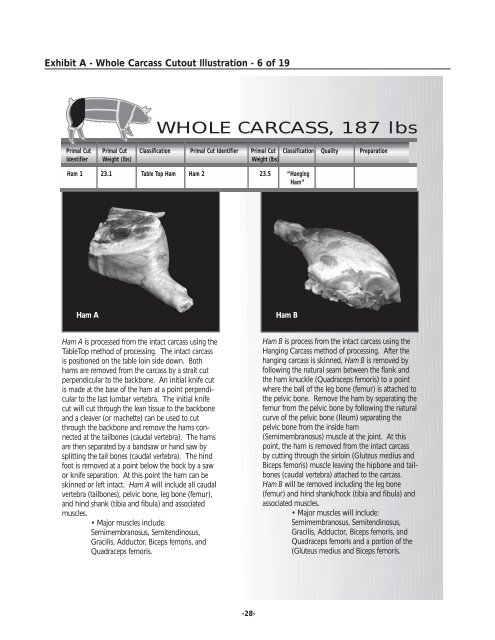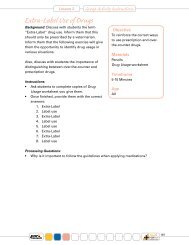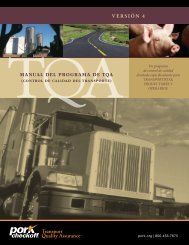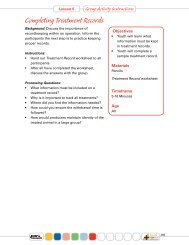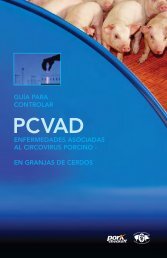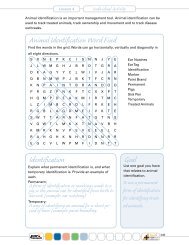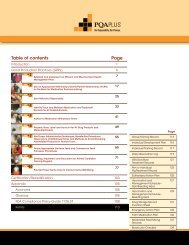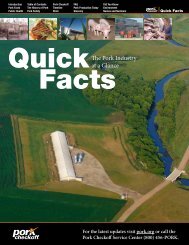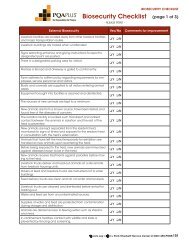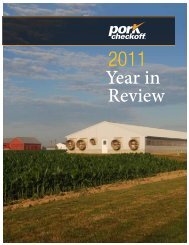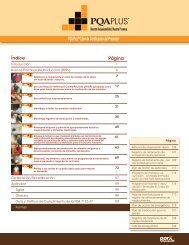Case Studies of Value Added Production and Marketing
Case Studies of Value Added Production and Marketing
Case Studies of Value Added Production and Marketing
Create successful ePaper yourself
Turn your PDF publications into a flip-book with our unique Google optimized e-Paper software.
Exhibit A - Whole Carcass Cutout Illustration - 6 <strong>of</strong> 19<br />
WHOLE CARCASS, 187 lbs<br />
Primal Cut Primal Cut Classification Primal Cut Identifier Primal Cut Classification Quality Preparation<br />
Identifier Weight (lbs) Weight (lbs)<br />
Ham 1 23.1 Table Top Ham Ham 2 23.5 “Hanging<br />
Ham”<br />
Ham A<br />
Ham B<br />
Ham A is processed from the intact carcass using the<br />
TableTop method <strong>of</strong> processing. The intact carcass<br />
is positioned on the table loin side down. Both<br />
hams are removed from the carcass by a strait cut<br />
perpendicular to the backbone. An initial knife cut<br />
is made at the base <strong>of</strong> the ham at a point perpendicular<br />
to the last lumbar vertebra. The initial knife<br />
cut will cut through the lean tissue to the backbone<br />
<strong>and</strong> a cleaver (or machette) can be used to cut<br />
through the backbone <strong>and</strong> remove the hams connected<br />
at the tailbones (caudal vertebra). The hams<br />
are then separated by a b<strong>and</strong>saw or h<strong>and</strong> saw by<br />
splitting the tail bones (caudal vertebra). The hind<br />
foot is removed at a point below the hock by a saw<br />
or knife separation. At this point the ham can be<br />
skinned or left intact. Ham A will include all caudal<br />
vertebra (tailbones), pelvic bone, leg bone (femur),<br />
<strong>and</strong> hind shank (tibia <strong>and</strong> fibula) <strong>and</strong> associated<br />
muscles.<br />
• Major muscles include:<br />
Semimembranosus, Semitendinosus,<br />
Gracilis, Adductor, Biceps femoris, <strong>and</strong><br />
Quadraceps femoris.<br />
Ham B is process from the intact carcass using the<br />
Hanging Carcass method <strong>of</strong> processing. After the<br />
hanging carcass is skinned, Ham B is removed by<br />
following the natural seam between the flank <strong>and</strong><br />
the ham knuckle (Quadraceps femoris) to a point<br />
where the ball <strong>of</strong> the leg bone (femur) is attached to<br />
the pelvic bone. Remove the ham by separating the<br />
femur from the pelvic bone by following the natural<br />
curve <strong>of</strong> the pelvic bone (Ileum) separating the<br />
pelvic bone from the inside ham<br />
(Semimembranosus) muscle at the joint. At this<br />
point, the ham is removed from the intact carcass<br />
by cutting through the sirloin (Gluteus medius <strong>and</strong><br />
Biceps femoris) muscle leaving the hipbone <strong>and</strong> tailbones<br />
(caudal vertebra) attached to the carcass.<br />
Ham B will be removed including the leg bone<br />
(femur) <strong>and</strong> hind shank/hock (tibia <strong>and</strong> fibula) <strong>and</strong><br />
associated muscles.<br />
• Major muscles will include:<br />
Semimembranosus, Semitendinosus,<br />
Gracilis, Adductor, Biceps femoris, <strong>and</strong><br />
Quadraceps femoris <strong>and</strong> a portion <strong>of</strong> the<br />
(Gluteus medius <strong>and</strong> Biceps femoris.<br />
-28-


